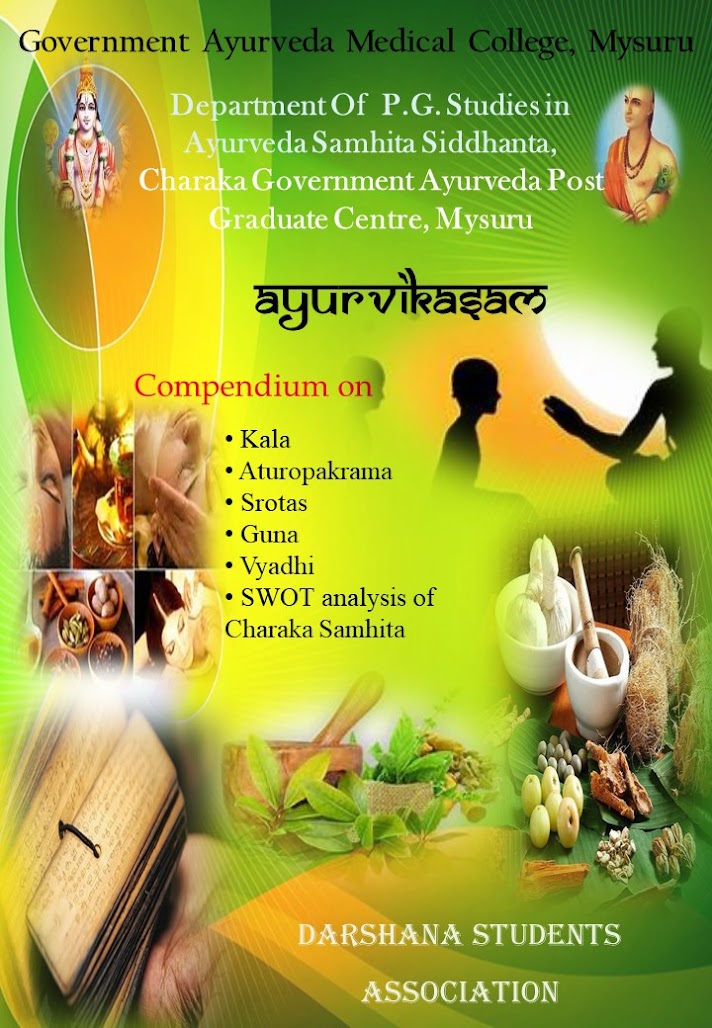The concept of Srotas is one of the most fundamental theories in Ayurveda. It is the
most debated topics in Ayurveda. The involvement of Srotas is mentioned in almost all the
diseases. Understanding the concept of Srotas is challenging because it is closely related to
both the anatomy and physiology of human body. Acharya Charaka has mentioned the
pathological involvements of Srotas in Nijavyadhis whereas Acharya Sushruta says that the
pathological involvement of Srotas begins only when their mula or origin is inflicted.
Contents of "Compendium on Srotas" are :-
INTRODUCTION TO SROTAS
PRANA VAHA SROTAS
ANNA VAHA SROTAS
UDAKA VAHA SROTAS
RASA VAHA SROTAS
RAKTHA VAHA SROTAS
MAMSA VAHA SROTAS
MEDO VAHA SROTAS
ASTHI VAHA SROTAS
MAJJA VAHA SROTAS
SHUKRA VAHA SROTAS
PURISHA VAHA SROTAS
MOOTRA VAHA SROTAS
SWEDA VAHA SROTAS
ANUKTHA SROTAS
COMPENDIUM ON 'GUNA'- DARSHANA SERIES - 4

The basic principles of Ayurveda are influenced by darshanas and the concept of padartha is not an exception. The padartha explained in darshana shastra is aimed at attainment of moksha. But Ayurveda advocates proper knowledge of padarthas for maintaining dhatu samyata which is the prerequisite for attaining moksha. Charaka samhita has described padartha in the first chapter of sutra sthana which highlights its importance. The padartha explained by Charaka samhita includes samanya, vishesha, guna, dravya, karma and samvaya,
Among these shat padarthas, dravya is said to be pradhana since it is the ashraya for guna and karma. Karma in turn is understood by the associated guna present in dravya. Thus proper understanding of guna helps to understand both dravya and karma in a better way. So this presentation is an attempt to understand the concept of guna from both Ayurvedic and Darshnika perspectives.
The Contents of "Compendium on Guna' is :-
Understanding concept of guna
Introduction to sharirika gunas
Concept and Application of:-
1. Guru-Laghu
2. Snigdha-Ruksha
3. Ushna-Sheeta
4. Tikshna-Manda
5. Sthira-Sara
6. Mrudu-kathina
7. Vishada-Pichchila
8. Shlakshna-Khara
9. Sukshma-Sthula
10. Sandra-Drava
11. 11. Vvavavi-Vikasi
12.Sugandha-Durgandha
Concept and Application of Anya Gunas
Concept and Application of Dosha Gunas
Concept and Application of Paradi gunas
1. Para apara
2. Yukthi sankhya
3. Samvoga vibhaga
4. Pruthakthva Parimana
5. Samskara abhyasa
Concept and Application of Saartha Gunas
Concept and Application of Atma gunas
1. Budhi
2. Sukha dukha
3. Dwesha
4. Ichha
5. Prayathna
COMPENDIUM ON 'VYADHI'- DARSHANA SERIES - 5
.jpeg)

.jpeg)


For Aturavikara Prashamana, the knowledge about disease origin and its progress is
very important. This knowledge regarding disease manifestation and stages of disease should
be understood properly to get good results in Chikitsa.
Vyadhi is the one which causes disturbances in mind and body; vyadhi may be due to
various etiological factors resulting in vitiation of tri doshas vitiated doshas starts to
accumulate in their own sites. This is followed by prakopaavastha, and then doshas leave
their own sites and come out, their prasara starts throughout the body. While they are in
prasara avastha if they find any kha vaigunya their sthanasamshraya occurs. This results in
manifestation of disease.
The Contents of "Compendium on Vyadhi" is :-
Review of literature:
Derivation
Definition
Synonyms
Classification
Vyadhi ashrayas
1) Nidanarthakarathva
2) Hethusankaratva
3) Vyadhisankarathva
4) Guruvyadhita and lagu vyadhita
5) Stages occuring due to changes in doshas
Kriya kala
Vegaavstha avegavastha
Dhosha paka
6) Stages occuring due to changes in dushya
Dhathupakavastha
Dhathu gatavastha
Nava-jeerna avastha
Uttana-gambhira avastha
7) Stages occuring due to change in condition of srothrodha or srothovaigunya
Antarvegi-bahirvegi avastha
Ajathodaka-pichavastha-jalodaka avstha
8) Stages occurring due to change in condition of ama and agnimandya
Sama-nirama avastha
Asukari-chirakari avastha
9) Santharpanotha-apatharpanotha vyadhis
Contemporary view
Discussion
Conclusion
COMPENDIUM ON'SWOT ANALYSIS OF CHARAKA SAMHITA '- DARSHANA SERIES - 6
Critical analysis along with classics is the best expedient. Different advancements
facilitate to understand the ayurvedic treatises in better way. In other way recent
technologies and methodologies of different fields should be utilized to understand
and implement Ayurveda literature in better way. Jnana (Real and True
Knowledge) can be obtained through Shastra (Concepts and Applications) as well
as Tarka (Critical Analysis).SWOT-Analysis, an emerging methodology in all
fields of life certainly can be utilized to understand the Samhitas appropriately.
Even though strengths and opportunities are enumerable in the field of Ayurveda,
there are weaknesses and threats in this field due to ignorance of people of
Ayurveda.
Here an effort has been made to analyse Charaka Samhita with the background of
SWOT analysis. ‘Traditional meets Technology’ is the main theme of this effort.
Contents of " Compendium on SWOT analysis of Charaka Samhita " :-
INTRODUCTION
SWOT ANALYSIS
SWOT ANALYSIS OF
SUTRA STHANA
SWOT ANALYSIS OF
NIDANA STHANA
SWOT ANALYSIS OF
VIMANA STHANA
SWOT ANALYSIS OF
SHAARIRA STHANA
SWOT ANALYSIS OF
INDRIYA STHANA
SWOT ANALYSIS OF
CHIKITSA STHANA
SWOT ANALYSIS OF
KALPA STHANA
SWOT ANALYSIS OF
SIDDHI STHANA

.jpeg)

.jpeg)

.jpeg)

.jpeg)



.jpeg)
.jpeg)

.jpeg)
.jpeg)

.jpeg)
















.jpeg)
.jpeg)


.jpeg)

.jpeg)



.jpeg)

.jpeg)
.jpeg)


Comments
Post a Comment